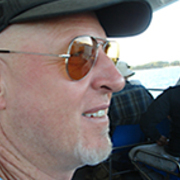
Rob Gillies
Rob Gillies first got interested in design in his father's garage workshop in Whanganui. There, among other things, he got busy turning surplus doors into tree huts.
Keen on painting, Gillies went on to study at Auckland's Elam School of Fine Arts, where he joined Split Enz as horn player. Distinctive visuals were a key part of the band's armoury. "We started to make our own film clips," Gillies recalls. "We were regarded as pretty impertinent when we turned up at the studio with a few ideas of our own on how we wanted to present ourselves". Gillies and fellow Enz musician Noel Crombie collaborated frequently on the band's early stage production and music videos, including the London-shot 'My Mistake' and the distinctive band-against-white clip for 'Bold as Brass' (1977).
In 1978, after a two year apprenticeship at Auckland's Mercury Theatre, Gillies joined the busy design team at new second channel South Pacific Television, then led by Antony Stones and Logan Brewer. Initially assigned to the light entertainment department, he found himself designing sets for entertainment legends Prince Tui Teka and Billy T James (in the retro-themed Radio Times).
Gillies also designed science fiction classic Under the Mountain, leading a team of 12 to create the memorable subterranean lair of the Wilberforces, slimy tunnels of mud and human figures who turn into slug-like monsters. Budgets were small in those pre-digital days, and the crew worked extremely collaboratively, eg juryrigging a camera-mounted mirror system which allowed people to magically disappear on screen.
In 1984 he left television to design his first movie, Other Halves, helping bring a stylish big city vibe to Sue McCauley's romance. His next TV project was kidult series Terry and the Gunrunners, which saw Gillies endeavouring "to find a visual equivalent" to the look of the original comic-book.
For chalk and cheese feature film comedy Ruby and Rata, Gillies and director Gaylene Preston initially scouted for locations around Wellington, before Gillies threw a curveball and suggested looking in Auckland. A 40s-style art deco house was soon found in Mount Albert. "It was just right," says Gillies. "It had a good feel to it for the character of Ruby." The house was purchased, and a set for Rata's flat added beneath, before the house was sold off at a profit. In the same period he also worked on TV thriller The Grasscutter, for director Ian Mune.
After doing art direction on a number of commercials, Gillies began a frenetic six year period creating castles, ruins, and villages for two ancient warriors. In the process, he helped provide concrete evidence to the international screen industry that New Zealand had the capacity — and the talent — to pull off bigger-budget, design-heavy productions.
First to launch (in 1995) was the Hercules: The Legendary Journeys series. His workload doubled when spin-off series Xena: Warrior Princess began shooting simultaneously. Working with a large team of carpenters, propmakers and painters, Gillies synchronised the creation of sets across an ever increasing number of warehouses around Auckland, plus another 12 exterior sets. He would win New Zealand television awards for both shows.
"I like the way you can drive through the suburbs, go into one of the industrial buildings we use and when you walk inside you are in a medieval street," said Gillies in 1998. "It's strange to be in there, then come out and be in the real streets again."
Gillies valued the creative latitude allowed him by American producer Rob Tapert, who had first brought Hercules and Xena to New Zealand. Since then he has worked with Tapert on a number of other productions shot down under: among the list, Gillies recreated America on Auckland soil for Boogeyman, and a 2012 remake of cabin in the woods classic The Evil Dead. He also designed TV series Legend of the Seeker and a personal favourite, Jack of All Trades, which won him another award. The show pairs Angela Dotchin with American Bruce Campbell in a period adventure ranging across the Pacific.
Since Xena went off air in 2001, Gillies has worked most often on feature films. 2003 Kiwi hit The World's Fastest Indian saw him handling local production design duties, opposite American designer J Dennis Washington (Thirteen Days). Gillies aimed for a "slightly dowdy post-war feel" in the New Zealand scenes, to contrast with the more colourful look when Burt Munro (Anthony Hopkins) and his motorcycle get to the USA.
One of the key sets was a detail-perfect recreation of Munro's garage, shot on a vacant Invercargill section. The use of a local signwriter (and part-time undertaker) saw him put in touch with some of Munro's old next door neighbours, who were able to vouch for the set's accuracy. Gillies managed to dress Timaru's wharves to double as both early 60s Christchurch, and for the Long Beach scenes when Munro arrives in the States.
Gillies next recreated Michigan — and elsewhere — for an acclaimed adaptation of fantasy novel Bridge to Terabithia. The film revolves around two children who find a tree house in the woods, and set about creating their own imaginary world.
Gillies also production designed David and Goliath tax tale We're Here to Help, the iconic crimson tree at the centre of fantasy series The Shannara Chronicles, and the 2004 stage version of Witi Ihimaera's The Whale Rider. His son Al has worked beside him on a number of productions, including Evil Dead.
Profile updated on 12 November 2020
Sources include
Rob Gillies
Mike Chunn, Stranger than Fiction - the Life and Times of Split Enz (Wellington: GP Publications, 1992)
Paul Smith, 'Scene-Setter' (Interview) - Pacific Wave magazine, March 1998
'Framework for design' (Interview) - Onfilm, July 1996, page 11
Robert Weisbrot, Xena Warrior Princess - The Official Guide to the Xenaverse (New York: Doubleday, 1998)